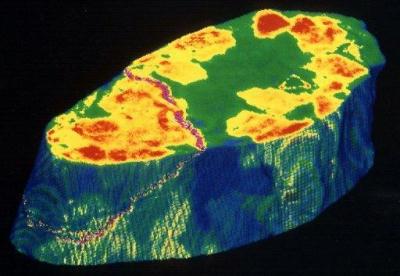Origin of Diamonds Found on the Ocean Floor
TORONTO, Ontario, Canada, May 1, 2003 (ENS) - Materials that form the gem diamonds mined in Guaniamo, Venezuela, originated on the ocean floor, according to a Canadian geologist who developed a new procedure to examine tiny inclusions in the gems.
Daniel Schulze, a geology professor at the University of Toronto at Mississauga, published a study today in the journal "Nature" which describes how diamonds are formed beneath the ocean deeps.
The diamond formation process begins, Schulze explains, when the Earth's mantle, the interior layer between the Earth's core and its crust, forces lava up onto the ocean's floor. The lava then solidifies into a volcanic rock called basalt.
Geology Professor Daniel Schulze specializes in study of Earth's upper mantle.(Photo courtesy University of Toronto) When the basalt interacts with sea water, its oxygen composition changes, Schulze says. "The volcanic rocks are altered to form new minerals. It's like the steel in your bicycle changing to rust in the rain."
Geological processes then move this altered basalt under the Earth's continental plates where heat and pressure turn the basalt into eclogite - red and green rocks that may contain diamonds, if carbon is present.
Over time, as the eclogite remains in the mantle, it eventually takes on the oxygen composition found in this environment.
"This process can erase or modify past evidence of the ecolgite's oceanic origins," says Schulze. "But because diamonds [contained within the eclogite] are impermeable, they act as time capsules, preserving inside themselves a record of conditions that existed during diamond formation."
In his study, Schulze and his team developed a new procedure using an ion microprobe to analyze tiny minerals, called coesite, in the diamonds.
Comparing these minerals to those in ocean altered basalts and mantle eclogite, the researchers found the coesite's oxygen composition a close match to that of the altered basalt, rather than the eclogite.
"This proves these diamonds have an oceanic heritage," Schulze says.
The fact that most minerals included in diamonds are very small - typically ten to a few hundred micrometres - has limited the variety of techniques that can be applied to diamond inclusion investigations, and until recently precluded oxygen isotope studies, the researchers say in the Nature paper.
It is the small beam diameter and high sensitivity of an ion microprobe that allows data to be collected from samples as tiny as minerals included in diamonds, and permits analysis of grains that are orders of magnitude smaller - nanograms - than possible by other methods, the scientists say.
"Using an ion microprobe and secondary-ion mass spectrometry (SIMS), we have now determined the oxygen isotope composition of mineral inclusions in eclogite-suite diamonds from the Guaniamo region of Venezuela, located on the Guyana shield," they write.
The Guaniamo area, located in western Bolivar State, Venezuela, is one of the most promising diamondiferous areas in South America, according to the Caracas based Guaniamo Mining Company which is now drilling in the area.

X-ray computed tomographic image of diamond bearing eclogite (Image by Diana Wiese courtesy U. Toronto)
The research team, which includes scientists from the geology departments at the University of Wisconsin and the University of Edinburgh as well as from the Guaniamo Mining Company, chose to examine this suite of materials because a number of features mark it as unusual, they said in the paper. "These include the facts that diamonds from this locality overwhelmingly belong to the eclogite suite, that coesite is unusually abundant as a diamond inclusion mineral, and that many of the diamonds have unusually low carbon isotope values."
Their analysis explains why mantle eclogites have an unusual oxygen composition compared to the surrounding mantle. "Although, over time, the eclogite assumes most of the mantle's oxygen characteristics, it may not have completely lost the oxygen composition it inherited as ocean altered basalt," says Schulze.
In addition, these particular diamonds, he says, seem to have "biogenic" carbon signatures, indicating that some of the carbon that formed the diamonds came originally from living organisms, such as ancient sea floor bacteria.
"Attached to the altered basalts, this carbon would have, in essence, gone along for the ride as the rock was thrust under the continents," the geologist explains. Heat and pressure would have turned the organic carbon into pure carbon in the form of graphite and, then finally, into diamond, he says.
Studying diamonds is one of the only ways scientists can learn about what is found deep beneath the Earth's crust and also the history of the early Earth and the environmental conditions that existed when the diamonds were formed.
"These tiny time capsules have indeed provided the missing link between the mantle and the crust," said Schulze.
Funding for this study was provided by the Natural Sciences and Engineering Research Council of Canada and the National Science Foundation.
Schulze is also researching diamond materials from Canada, United States, southern Africa, and Russia.